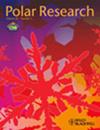利用 DNA 条形码识别北极麝香狐粪便中的无脊椎动物物种
IF 1.3
4区 地球科学
Q3 ECOLOGY
引用次数: 0
摘要
北极正在经历强烈的环境变化,影响着物种和整个生物群落。为了评估对这些群落的影响,包括它们的组成和功能,我们需要更多关于它们目前分布和生物学的信息。在高北极冻土带,动物的粪便,如麝牛(Ovibos moschatus),是一个相对未被充分研究的微栖息地,可能对以粪便为食的昆虫和胃肠道寄生虫等生物有吸引力。使用DNA条形码方法,我们检查了来自格陵兰两个地区的麝鼠粪便中的粪便生活无脊椎动物。在15%的样本中,我们发现了双翅目和鳞翅目昆虫物种的DNA。腐生双翅目在格陵兰岛西部和东北部以及夏季和冬季的粪便定植不同。此外,我们在两个地区的样本中都发现了麝香粪便中含有内寄生线虫。然而,我们没有在土壤中发现腐食节肢动物的痕迹,如刺虫和螨虫。我们的初步研究首次揭示了生活在这个被忽视的北极微栖息地的无脊椎动物。本文章由计算机程序翻译,如有差异,请以英文原文为准。
Identifying invertebrate species in Arctic muskox dung using DNA barcoding
The Arctic is undergoing strong environmental changes, affecting species and whole biological communities. To assess the impact on these communities, including their composition and functions, we need more information on their current distribution and biology. In the High-Arctic tundra, dung from animals, such as muskoxen (Ovibos moschatus), is a relatively understudied microhabitat that may be attractive for organisms like dung-feeding insects as well as gastrointestinal parasites. Using a DNA barcoding approach, we examined muskox droppings from two Greenlandic regions for dung-dwelling invertebrates. In 15% of all samples, we found the DNA of insect species in the orders Diptera and Lepidoptera. The saprophagous Diptera colonized dung differently in west versus north-east Greenland and summer versus winter. In addition, we found muskox dung harbouring endoparasitic nematodes in samples from both regions. However, we could not find traces of saprophagous arthropods, such as collembolans and mites, from the soil sphere. Our pilot study sheds a first light on the invertebrates living in this neglected Arctic microhabitat.
求助全文
通过发布文献求助,成功后即可免费获取论文全文。
去求助
来源期刊

Polar Research
地学-地球科学综合
CiteScore
3.20
自引率
5.30%
发文量
22
审稿时长
>12 weeks
期刊介绍:
Since 1982, Polar Research has been the international, peer-reviewed journal of the Norwegian Polar Institute, Norway''s central institution for research, environmental monitoring and mapping of the polar regions. Aiming to promote the exchange of scientific knowledge about the Arctic and Antarctic across disciplinary boundaries, Polar Research serves an international community of researchers and managers. As an open-access journal, Polar Research makes its contents freely available to the general public.
Original primary research papers comprise the mainstay of Polar Research. Review articles, brief research notes, letters to the editor and book reviews are also included. Special issues are published from time to time.
The scope of Polar Research encompasses research in all scientific disciplines relevant to the polar regions. These include, but are not limited to, the subfields of biology, ecology, geology, oceanography, glaciology and atmospheric science. Submissions from the social sciences and those focusing on polar management and policy issues are welcome. Contributions about Antarctica are particularly encouraged.
 求助内容:
求助内容: 应助结果提醒方式:
应助结果提醒方式:


